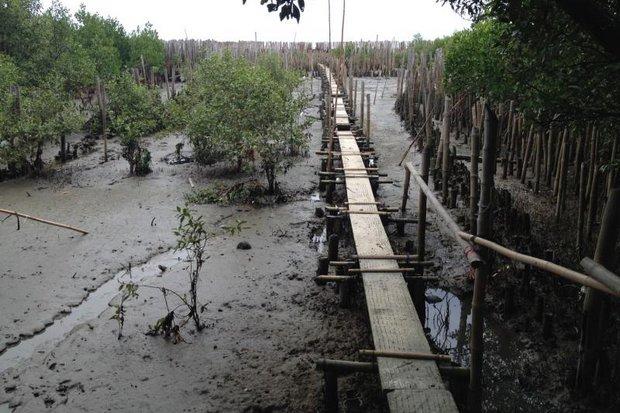
The reclaimed mud land along the shore of Samut Sakhon. Villagers have built rows of bamboo poles on the shoreline to prevent coastal erosion. (Photo by Paritta Wangkiat)
For years, villagers in Samut Sakhon’s tambon Khok Kham have watched the shoreline erode, not only damaging coastal marine life, but also encroaching on their homes and schools, forcing them to relocate to inner land.
Authorities tried using rocks and building concrete structures on the shore to prevent further damage.
But no one knew how to reclaim the five to 10 metres of muddy land that disappear from the shoreline every year.
It wasn’t until 2003 that a group of villagers launched their own erosion prevention project by putting up rows of bamboo poles on the shoreline.
The bamboo sticks act as wavebreaking barriers while also allowing sediment to be stored behind them.
The locals learned the technique from mussel growers after they saw how sediment accumulated at bamboo poles placed in the sea to grow mussels.
“We learned that coastal mud is important for our livelihood, as much as it is for marine animals. So we began to try to get it back,” said villager Worachart Janthong.
Within five years, about 100 rai of the mud land which had disappeared had re-emerged at a depth of one metre, said Mr Worachart.
Villagers planted mangrove trees on the reclaimed mud land to replace the decaying bamboo poles. Some marine life, including four species of mudskippers, reappeared, he said.
The locals planned to expand the mangrove forest, hoping to revive marine animals, the source of their food security, and prevent further erosion.
Several communities along the north of the Gulf of Thailand, where the shore is naturally muddy, have adopted this as a long-term strategy.
“Our success has proved that building concrete structures to prevent coastal prevention isn’t the solution,” said Mr Worachart.
But the eroded coastline in Samut Sakhon is only a small part of the problem facing the country.
According to the Department of Marine and Coastal Resources (DMCR), Thailand has 3,148 kilometres of shoreline.
Of this, 830km — 730km in the Gulf of Thailand and 100km in Andaman coast — is being eroded. Eroded shorelines, from Samut Sakhon to Chachoengsao province, are at a critical point.
In most cases, authorities built concrete walls, offshore breakwater sea walls, revetments (sloping structures that absorb the energy of incoming water) or jetties to prevent erosion. However, some academics said these solutions led to even worse erosion.
In a recent case in Songkhla province, a shoreline erosion prevention project by the governor, using sand filling and large concrete groynes along Samila-Chalatad beach, was largely opposed by locals.
They said the project would worsen erosion and damage fishing prospects at the site.
Construction was halted after the Songkhla Administration Court inspected the site last week.
The governor agreed to suspend the project until the court hands down a ruling. Locals, officials, and environmental experts will meet for talks on Wednesday.
Sakanan Plathong, lecturer at the Biology Department, Faculty of Science, at Prince of Songkla University, said concrete structures would not be a good solution as the erosion would simply move to a nearby spot away from the structures.
He cited the case of a jetty that was built on the coast of Songkhla’s Thepha district to prevent erosion, but resulted in sand being stuck on one side of the structure, with erosion on the other side.
“The shoreline will eventually be destroyed,” he said.
Mr Sakanan said the South’s sandy coastline differed from the muddy one of Samut Sakhon, and that it would not be possible to use the Samut Sakhon villagers’ bamboo pole technique there.
Erosion in the South is a battle that can’t be won, he said.
“But it’s getting worse with man-made structures.”
He suggested authorities use their money for the expropriation of eroded lands and relocate the owners rather than attempting to fight nature.
Thon Thamrongnawasawat, a member of the National Reform Council (NRC), included the erosion issue in the NRC’s Thai Sea Reform Plan, to be sent to cabinet soon.
The plan proposes that the DMCR, as the lead agency dealing with coastal resources, should work with state authorities to investigate private and state construction projects that may cause erosion.
The DMCR should suspend projects that are found to have a tendency to damage the coast, the plan says.
Mr Thon said the goal of marine management is to maintain the coast line as it is, and not lose more shoreline to erosion.
Source: http://www.bangkokpost.com/news/general/675060/fight-against-coastal-erosion
